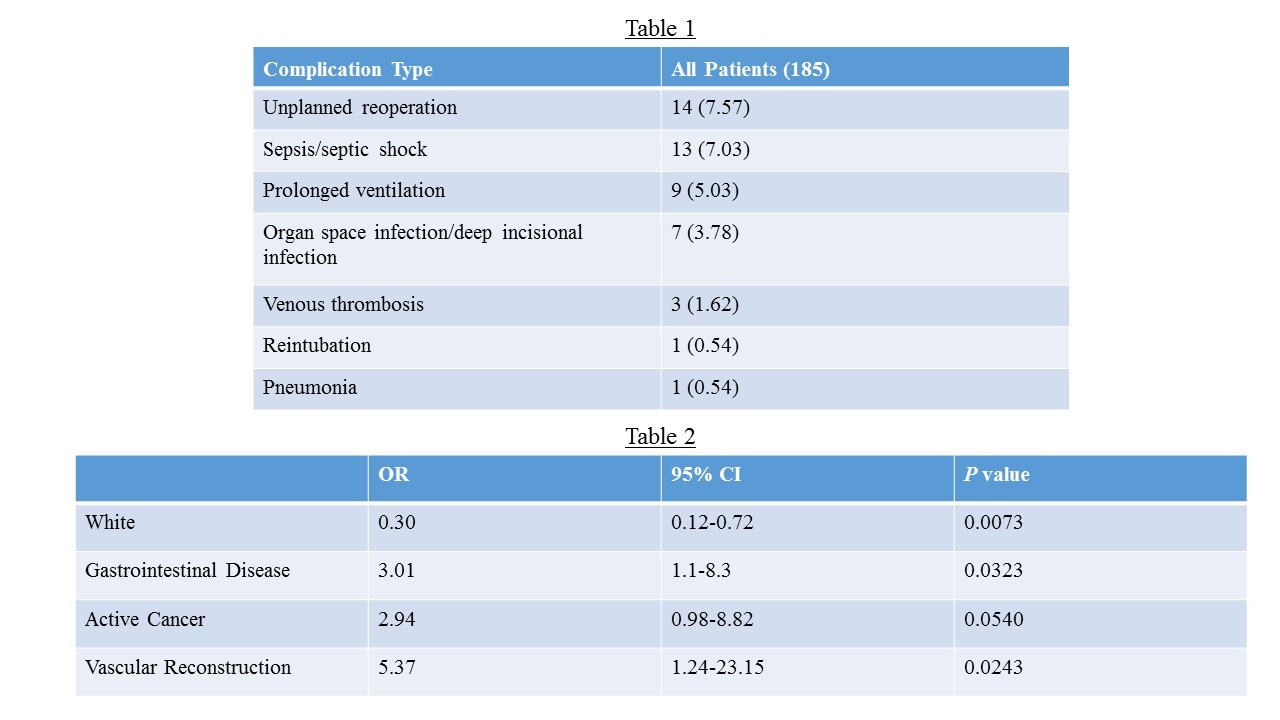OS2-140
Predicting Poor Outcomes Following Pediatric Hepatectomy
Vargas A, Wasson N, Lee J, Lemoine C, Superina R, Cheon E
Ann & Robert H. Lurie Children's Hospital of Chicago, Chicago, IL, USA
Introduction: For pediatric patients undergoing hepatectomy, postoperative morbidity and mortality remain high (1). However, there is limited pediatric data regarding perioperative risk factors for postoperative complications. The aim of this analysis is to determine the incidence, preoperative characteristics, and intraoperative factors predictive of poor outcome following pediatric hepatectomy. We hypothesized that increased surgical complexity, increased operative time, hepatectomy type, and malignancy would independently predict postoperative complications.
Methods: Using ACS NSQIP-P, patients undergoing hepatic lobectomy, trisegmentectomy, total left lobectomy, and total right lobectomy from January 1, 2012 to December 31, 2013 were identified using CPT codes. The primary outcome was a composite of thirteen serious post-operative complications (2). Univariable analyses were performed on fifty possible risk factors to identify any correlation with postoperative complications. Patient characteristics were compared using Student’s t-test for continuous variables and Pearson chi-square for categorical variables. These variables were used to create multivariable logistic regression models to identify independent predictors for postoperative complications.
Results: 185 patients were included in the final analysis. There were 48 postoperative complications experienced by 30 patients (16.2%) within the first thirty postoperative days (Table 1). There were no deaths, cardiac arrest, PE, coma, deep wound dehiscence, or renal failure. Multivariable logistic regression models showed that independent predictors of poor outcome include concomitant gastrointestinal (GI) disease, active cancer, and vascular reconstruction. White race was associated with decreased complications (Table 2). Hepatectomy type and operative time were not associated with poor outcome.
Discussion/Conclusion: We demonstrate that significant postoperative complications occur following pediatric hepatectomy with an incidence of 16.22%. The most common complications were unplanned reoperation, sepsis, and prolonged postoperative ventilation. Independent predictors for postoperative complications were concomitant GI disease, active cancer, and vascular reconstruction. As in adult studies (3), white race was associated with decreased complications. Neither hepatectomy type nor operative time predicted poor outcomes.
References
1. Zwintscher NP, Azarow KS, Horton JD: Morbidity and mortality associated with liver resections for primary malignancies in children. Pediatr Surg Int 2014; 30: 493-7
2. Paruch JL, Merkow RP, Bentrem DJ, Ko CY, Posner MC, Cohen ME, Bilimoria KY, Weber SM: Impact of hepatectomy surgical complexity on outcomes and hospital quality rankings. Ann Surg Oncol 2014; 21: 1773-80
3. Nathan H, Frederick W, Choti MA, Schulick RD, Pawlik TM. Racial Disparity in Surgical Mortality after Major Hepatectomy. J Am Coll Surg. 2008;207(3):312-319.
Top












